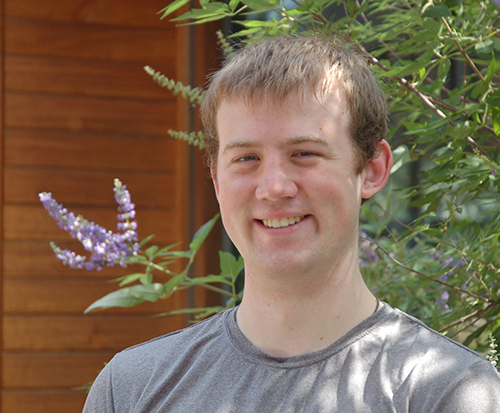 First-year CS Ph.D. student Andrew Wells recently won a NASA Space Technology Research Fellowship (NSTRF17) that could fund his work in robotics for up to four years.
First-year CS Ph.D. student Andrew Wells recently won a NASA Space Technology Research Fellowship (NSTRF17) that could fund his work in robotics for up to four years.
Wells is a member of Lydia Kavraki’s research team and his successful application proposed research in task and motion planning, an area he was introduced to by one of Kavraki’s former Ph.D. students.
“My advisor at the Catholic University of America, Dr. Erion Plaku, completed his Ph.D. with Lydia. As I considered graduate programs, he recommended Rice and Lydia,” said Wells.
“Then I came to visit during recruiting weekend and I really liked the people I met. Lydia’s research interests in two apparently unrelated fields—robotics and bioinformatics—appealed to me. I like learning for its own sake, not just because it can be useful, but I also suspect there is a lot of low-hanging fruit that can be discovered by someone with broader interests in more than one sub-field.”
Kavraki had already blended her own disparate interests in biology, computer science, and robotics, and Wells choose the graduate program at Rice because he knew his advisor would be open to exploring things that might not be immediately useful in the field of robotics. “I wanted an advisor who would be supportive of taking apparently useless classes.” Wells laughed. “After all, I have a degree in philosophy.”
His current research is in task and motion planning. “The research I completed as an undergraduate was entirely in motion planning, but the NASA fellowship is for the more difficult problem of integrated task and motion planning.” Wells outlined three objectives of the project.
“First, we want the robot to be able to do something, like find an object in cargo bags and bring it to the astronauts. Right now, it requires in-depth knowledge to specify what you want the robot to do and how it’s allowed to do it. Basically we want an interface that can be used without a Ph.D. in robotics.”
He said the second goal is to develop better algorithms for task and motion planning. For example, the task of retrieving a cargo bag can be broken into a sequence of discrete task-level actions: move to the bag, grasp the bag, move the bag to the goal location. Each action is then a continuous motion-planning problem.
Wells says, “Individually, task planning and motion planning are hard problems, but they are at least fairly well understood. When we combine task and motion planning, new issues arise because we are mixing algorithms that are designed for different purposes. Task planning is discrete while motion planning is continuous.”
Wells appreciates the opportunity to build robots and work on real problems with NASA. “I generally prefer the theoretical side of the theory-to-practice spectrum, but you can have both. With a robot, you can apply the theory and see it working on a physical system.
“Working with NASA on their specific challenges puts an even more interesting spin on it—your research may eventually be used for something really cool, like going to Mars. After a lot of testing,” he adds with a grin.
Andrew Wells’ Ph.D. adviser is Lydia Kavraki; he matriculated in Fall 2016.
